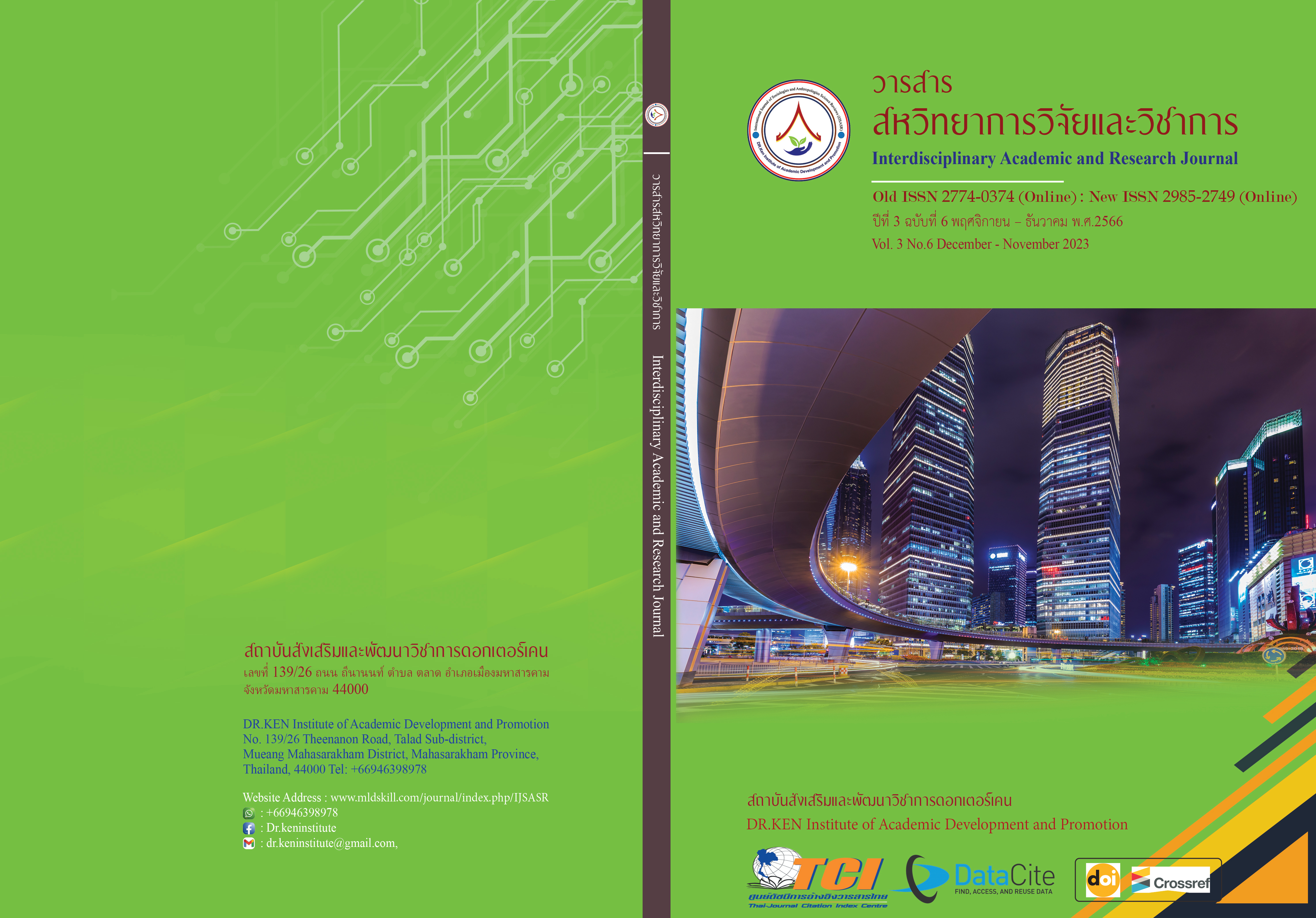The Development of Academic Achievement of Basic Accounting by Organizing Collaborative Learning Activities through Think-Pair-Share for First-year Vocational Certificate Students
DOI:
https://doi.org/10.60027/iarj.2023.271774Keywords:
Organizing Learning Activities; , Collaborative Group; , Think-Pair-Share; , Public MediaAbstract
Background and Aims: Organizing learning in the subject of basic accounting is teaching and learning, emphasizing actual practice for students to train themselves, to practice skills so that students can actually practice. Upon graduation according to the curriculum, learners must have real knowledge, skills, and the ability to practice. The research Accounting Skill Development through Think-Pair-Share for first-year vocational certificate students. Study of low achievement problems, Learning efficiency, and Student satisfaction. Using collaborative learning activities Think-Pair-Share and Skill Exercises improve quality and efficiency. Which is the problem of this research. This study aims to 1) develop a cooperative learning activity of Think-Pair-Share for first-year vocational certificate students with the effective criteria of 80/80, 2) compare the academic achievement of first-year vocational certificate students before and after learning through the Think-Pair-Share with the effective criteria of 80 percent, and 3) to investigate the satisfaction of first-year vocational certificate students with the Think-Pair-Share cooperative learning activity.
Methodology: The samples used in the research were 30 first-year vocational certificate students in one class of accounting major in the two semesters of the academic year 2023 at Nong Han Vocational College under the Office of the Vocational Education Commission, Udon Thani Province. They were included in the study through group random sampling. The research instruments were 1) a lesson plan, 2) an academic achievement test, and 3) a satisfaction survey. Statistics used in data analysis included percentage, mean, standard deviation, and t-test statistics (one-sample t-test).
Results: The study revealed three findings. First, the effectiveness of Think-Pair-Share cooperative learning of first-year vocational certificate students was 84.78/83.33, which was higher than the criteria. Second, students demonstrated academic achievement after Think-Pair-Share cooperative learning higher than the criteria of 80 percent, with a statistical significance level of .05. Lastly, first-year vocational certificate students reported the highest level of satisfaction with the Think-Pair-Share cooperative learning activity.
Conclusion: The collaborative learning activities employing peer-teaching techniques significantly enhance the effectiveness of education for first-year professional certificate students, as evidenced by high-efficiency scores and improved academic performance, resulting in the utmost satisfaction among the students.
References
กระทรวงศึกษาธิการ. (2562). หลักสูตรประกาศนียบัตรวิชาชีพ พุทธศักราช 2562. กรุงเทพฯ : สำนักงานคณะกรรมการอาชีวศึกษา.
เทพบุตร หาญมนตรี. (2563). การพัฒนากิจกรรมการเรียนรู้แบบร่วมมือเทคนิคเพื่อนคู่คิดเพื่อส่งเสริมความสามารถในการแก้ปัญหาทางคณิตศาสตร์ เรื่อง ดอกเบี้ยและมูลค่าของเงินของนักเรียนชั้นมัธยมศึกษาปีที่ 5.(วิทยานิพนธ์การศึกษามหาบัณฑิต) มหาสารคาม: มหาวิทยาลัยมหาสารคาม.
นวกานต์ วิภาสชีวิน. (2564). ผลการจัดการเรียนรู้โดยใช้รูปแบบ SSCS ร่วมกับเทคนิคเพื่อนคู่คิด (Think -Pair-Share) เรื่อง สถิติ ที่มีต่อการพัฒนาความสามารถในการแก้ปัญหาและความสามารถในการทำงานเป็นทีมของนักเรียนชั้นมัธยมศึกษาปีที่ 1. วิทยานิพนธ์วิทยาศาสตรมหาบัณฑิต: มหาวิทยาลัยศิลปากร.
นารีรัตน์ ประสมสาสตร์. (2562). ผลการจัดการเรียนรู้คณิตศาสตร์ด้วยการเรียนรู้เชิงรุกร่วมกับเทคนิคเพื่อนคู่คิดที่มีต่อความสามารถในการแก้ปัญหาและผลสัมฤทธิ์ทางการเรียนคณิตศาสตร์ของนักเรียนชั้นมัธยมศึกษาปีที่ 3. วารสารศึกษาศาสตร์มหาวิทยาลัยมกุฎราชวิทยาลัย, 7(2), 495-508.
นาอีม บินอิบรอเฮง. (2563). การใช้เทคนิคแผนผังความคิดร่วมกับการเรียนรู้แบบร่วมมือเพื่อนคู่คิดสี่สหายเพื่อพัฒนาความคิดสร้างสรรค์ เรื่อง ความสัมพันธ์และฟังก์ชัน ของนักเรียนชั้นมัธยมศึกษาปีที่ 4 โรงเรียนเบญจมราชูทิศ จังหวัดปัตตานี. วิทยานิพนธ์การศึกษามหาบัณฑิต: มหาวิทยาลัยศิลปากร.
พรปวีณ์ จันทร์ธรรม. (2565). ผลการจัดการเรียนรู้เชิงรุกร่วมกับเทคนิค Think - Pair - Share ที่มีผลต่อความสามารถในการให้เหตุผลและผลสัมฤทธิ์ทางการเรียนคณิตศาสตร์ของนักเรียนชั้นมัธยมศึกษาปีที่ 3. วารสารคณะครุศาสตร์ มหาวิทยาลัยนครสรรค์, 5(2), 8-16.
วิทยาลัยการอาชีพหนองหาน. (2565). รายงานผลสัมฤทธิ์ทางการเรียนวิชาการบัญชีเบื้องต้น ปีการศึกษา 2565. อุดรธานี: วิทยาลัยการอาชีพหนองหาน.
ศิกานต์ เพียรธัญญกรณ์. (2560). การจัดการเรียนรู้. สกลนคร: มหาวิทยาลัยราชภัฏสกลนคร.
สุพัตรา ศรีวิไล. (2565). การพัฒนาผลสัมฤทธิ์ทางการเรียนการแก้โจทย์ปัญหาคณิตศาสตร์ โดยใช้เทคนิค Know Want Condition (KWC) ร่วมกับเทคนิค Think-Pair-Share ของนักเรียนชั้นประถมศึกษาปีที่ 5 โรงเรียนในเครือข่ายนวมิตร สังกัดคณะกรรมการส่งเสริมการศึกษาเอกชนสงขลา. วิทยานิพนธ์การศึกษามหาบัณฑิต: มหาวิทยาลัยหาดใหญ่.
อภิรดี พุดเผือก. (2559). การพัฒนารูปแบบการเรียนรู้แบบร่วมมือและเพื่อนคู่คิดที่มีการแข่งขันเป็นทีมภายใต้สภาพแวดล้อมของการเรียนรู้ผสมผสานระหว่างวิธีการเรียนรู้ออนไลน์และออฟไลน์. (วิทยานิพนธ์ปรัชญาดุษฎีบัณฑิต) กรุงเทพฯ: มหาวิทยาลัยเทคโนโลยีพระจอมเกล้าธนบุรี.
อุษา ภิรมย์รักษ์. (2562). การพัฒนาความสามารถในการแก้ปัญหาทางคณิตศาสตร์ด้วยการจัดการเรียนรู้แบบการสอนแนะให้รู้คิด (CGI) ร่วมกับเทคนิคเพื่อนคู่คิด (Think Pai-Share) ของนักเรียนชั้นมัธยมศึกษาปีที่ 4. วิทยานิพนธ์วิทยาศาสตรมหาบัณฑิต: มหาวิทยาลัยศิลปากร.
Scanniello, G., & Erra, U. (2014). Distributed modeling of use case diagrams with a method based on think-pair-square: Results from two controlled experiments. Journal of Visual Languages & Computing. 25 (4), 494-517. https://doi.org/10.1016/j.jvlc.2014.03.002
Lyman, F. (1981). Think-Pair-Share: An expanding teaching technique. MAA - CIE Cooperative News.
Downloads
Published
How to Cite
Issue
Section
License
Copyright (c) 2023 Nucharin Khammanard, Nattachai Juntachum , Darunnapa Nachairit

This work is licensed under a Creative Commons Attribution-NonCommercial-NoDerivatives 4.0 International License.
Copyright on any article in the Interdisciplinary Academic and Research Journal is retained by the author(s) under the under the Creative Commons Attribution-NonCommercial-NoDerivatives 4.0 International License. Permission to use text, content, images, etc. of publication. Any user to read, download, copy, distribute, print, search, or link to the full texts of articles, crawl them for indexing, pass them as data to software, or use them for any other lawful purpose. But do not use it for commercial use or with the intent to benefit any business.
















.png)


